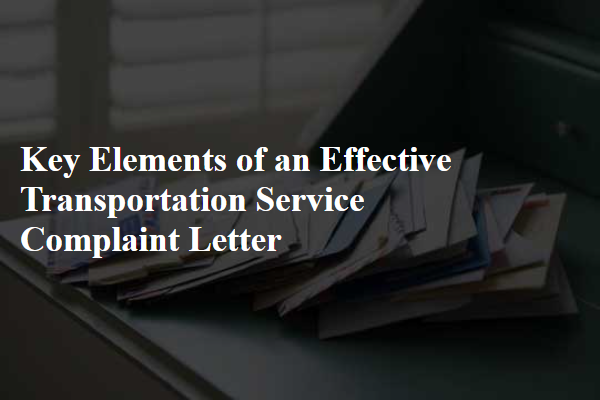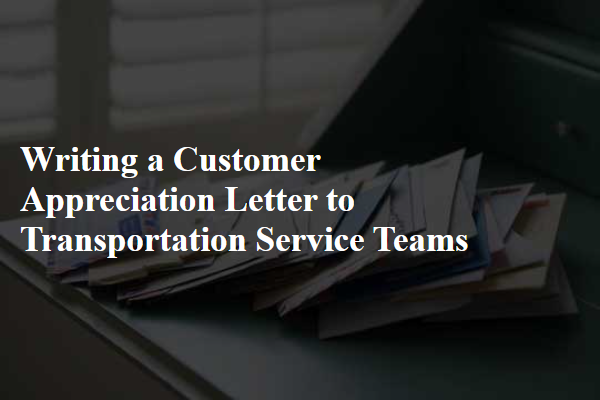
An effective transportation service complaint letter clearly states the specific issue, including relevant details such as dates, locations, and service numbers to ensure accurate identification of the problem. It maintains a respectful and professional tone while expressing dissatisfaction, which helps facilitate constructive communication with the service provider. The letter also requests a clear resolution or compensation, outlining expectations to guide the company in addressing the complaint efficiently.
Clear Identification of the Complainant
| Key Element | Description | Importance |
|---|---|---|
| Clear Identification | Include the sender's name, contact details, and any relevant account or ticket numbers. | Ensures the transportation provider can accurately locate the customer's information and respond promptly. |
| Precise Description of the Issue | Detail the problem encountered such as delays, damaged goods, poor service, or safety concerns. | Helps the service provider understand the specific complaint for targeted resolution. |
| Date, Time, and Location Details | Specify when and where the issue occurred to aid in investigation. | Provides crucial context for verifying the complaint and improving service operations. |
| Supporting Evidence | Attach receipts, photos, tickets, or communication records related to the complaint. | Strengthens the credibility of the complaint and speeds up the verification process. |
| Desired Resolution | Clearly state the outcome you expect, such as refund, apology, or service correction. | Guides the service provider in addressing the complaint satisfactorily. |
| Polite and Professional Tone | Maintain a respectful and courteous language throughout the letter. | Facilitates constructive communication and increases chances of positive response. |
| Concise and Structured Format | Organize the letter logically with short paragraphs and clear points. | Improves readability and ensures the complaint is easily understood. |
Detailed Description of the Incident
An effective transportation service complaint letter clearly outlines the issue experienced by the customer while maintaining a professional tone. It provides specific details to facilitate a prompt and appropriate response from the service provider.
- Clear Identification of the Problem - Describe the exact nature of the transportation service failure, including dates, locations, and service type.
- Concise and Professional Language - Use polite and formal language to convey the complaint without emotional exaggeration.
- Requested Resolution - Specify the desired outcome, such as a refund, apology, or service correction, to guide the provider's response.
Date and Time of the Event
Writing an effective transportation service complaint letter requires clarity and precision to ensure the issue is addressed promptly. Highlighting key elements enhances the letter's impact and facilitates resolution.
- Clear Identification - Specify the transportation service, date, time, and location to provide context for the complaint.
- Concise Description of the Problem - Detail the issue encountered with factual and objective information to avoid misunderstandings.
- Requested Resolution - State the desired outcome or compensation clearly to guide the service provider toward an appropriate response.
Specific Location Information
An effective transportation service complaint letter clearly states the issue experienced during the service. It includes specific details such as date, time, and location to ensure accurate identification of the problem.
Providing clear and precise descriptions of delays, damages, or poor customer service helps the company understand the complaint fully. Including relevant documentation, such as receipts or photos, strengthens the case. A polite and concise tone increases the likelihood of a positive response.
Identification of Involved Personnel or Vehicle
An effective transportation service complaint letter clearly states the issue, providing specific details such as date, time, and location of the incident. It includes a description of the problem's impact on the customer and any supporting evidence like ticket numbers or photos. The letter also requests a specific resolution, such as a refund or service improvement, ensuring clear communication for prompt action.
Impact on the Passenger or Service Experience
An effective transportation service complaint letter must clearly state the issue and provide specific details such as dates, times, and locations. Including the service provider's name and the nature of the problem helps ensure the complaint is properly addressed.
Providing evidence like tickets, receipts, or photographs strengthens the complaint's validity. A respectful tone and a clear request for resolution improve the chances of a positive response from the transportation company.
Supporting Evidence or Documentation
An effective transportation service complaint letter clearly identifies the issue and provides relevant details such as date, time, and location. Clear communication helps the service provider understand the problem and address it promptly.
Including specific examples and any supporting evidence strengthens the complaint's credibility. A polite and professional tone encourages a positive response and resolution from the company.
Desired Resolution or Action Requested
Writing an effective transportation service complaint letter requires clarity and detail to ensure the issue is addressed promptly. Key elements help structure the letter for maximum impact and resolution.
- Clear Description of the Issue - Precisely outline the problem experienced with the transportation service to provide a clear context.
- Relevant Details - Include date, time, location, and any identifying information like ticket numbers or vehicle details for accurate reference.
- Requested Resolution - State the desired outcome or compensation to guide the service provider toward resolving the complaint.
Incorporating these elements ensures the transportation service complaint letter is professional, concise, and effective in facilitating a resolution.
Contact Information for Follow-Up
A transportation service complaint letter must clearly state the issue, including specific details such as date, time, and location of the incident. It should provide evidence or descriptions of the problem, like delays, damaged goods, or poor customer service. The letter must also include a requested resolution, such as a refund, compensation, or an apology.
Professional and Respectful Tone
What are the key elements of an effective transportation service complaint letter?
An effective complaint letter must clearly state the issue and provide relevant details such as dates, times, and locations. Including specific examples and desired resolutions enhances the letter's impact and increases the likelihood of a satisfactory response.



Comments